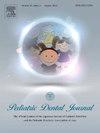Integration of single cell analysis of dental mesenchyme and human disease database identifies the responsible gene of dentin disorders
IF 0.8
Q4 DENTISTRY, ORAL SURGERY & MEDICINE
引用次数: 0
Abstract
Objectives
Dental anomalies are often associated with inherited diseases and are frequently seen in the field of pediatric dentistry. Dentin disorders are caused by genetic mutations of genes expressed in dental mesenchyme and these genetic mutations also cause skeletal dysplasia. However, only little genes are identified as the responsible gene of dentin disorders and therefore the genetic mechanism is poorly understood. Here, we identified the dental mesenchymal cell-specific genes using single-cell RNA-sequence (scRNA-seq) to clarify the pathogenesis of dentin disorders. Furthermore, we examined the association of inherited disease with dentin or skeletal abnormality using human disease database.
Materials and methods
scRNA-seq were performed using post-natal day (P) seven mice incisor. Total 6260 cells of scRNA-seq dataset was obtained. Top 20 differentially expressed genes (DEGs) in odontoblast cluster and dental pulp cluster were identified. Inherited diseases of DEGs and their Clinical Synopsis were examined using Online Mendelian Inheritance in Man (OMIM).
Results
The prevalence of inherited disease was 17/40 genes (42.5 %) and dental anomalies-associated inherited diseases were 12/35 diseases (34.3 %); 2.8 % in enamel abnormality, 14.3 % in dentin abnormality, and 17.1 % in other abnormality. The prevalence of dentin abnormality was 33.3 % in odontoblast and 7.7 % in dental pulp-associated diseases. The prevalence of skeletal abnormality in identified inherited diseases was 85.7 %.
Conclusion
The DEGs in dental mesenchymal cells were highly associated with dentin abnormality and skeletal abnormality. Identification of dental mesenchymal cell specific genes using scRNA-seq may uncover the novel genetic mechanism of dentin disorders.
整合单细胞分析牙本质间充质和人类疾病数据库确定牙本质疾病的负责基因
目的牙畸形常与遗传性疾病相关,是儿科牙科领域的常见病。牙本质疾病是由牙间质表达基因的基因突变引起的,这些基因突变也会导致骨骼发育不良。然而,只有很少的基因被确定为牙本质疾病的负责基因,因此遗传机制尚不清楚。在这里,我们使用单细胞rna序列(scRNA-seq)鉴定了牙本质间充质细胞特异性基因,以阐明牙本质疾病的发病机制。此外,我们使用人类疾病数据库检查了遗传疾病与牙本质或骨骼异常的关系。材料和方法采用出生后7天(P)小鼠切牙进行scrna测序。共获得scRNA-seq数据集6260个细胞。在成牙髓细胞簇和牙髓簇中鉴定出前20个差异表达基因(DEGs)。采用在线孟德尔遗传(OMIM)对deg的遗传病及其临床概况进行了分析。结果牙畸形相关遗传病患病率为12/35(34.3%),遗传疾病患病率为17/40 (42.5%);牙本质异常占14.3%,其他异常占17.1%。牙本质异常发生率在成牙细胞中为33.3%,在牙髓相关疾病中为7.7%。确定的遗传性疾病中骨骼异常的患病率为85.7%。结论牙髓间充质细胞DEGs与牙本质异常和骨骼异常密切相关。利用scRNA-seq技术鉴定牙本质间充质细胞特异性基因可能揭示牙本质疾病的新的遗传机制。
本文章由计算机程序翻译,如有差异,请以英文原文为准。
求助全文
约1分钟内获得全文
求助全文
来源期刊

Pediatric Dental Journal
DENTISTRY, ORAL SURGERY & MEDICINE-
CiteScore
1.40
自引率
0.00%
发文量
24
审稿时长
26 days
 求助内容:
求助内容: 应助结果提醒方式:
应助结果提醒方式:


